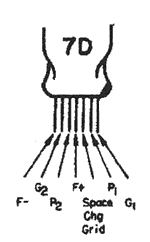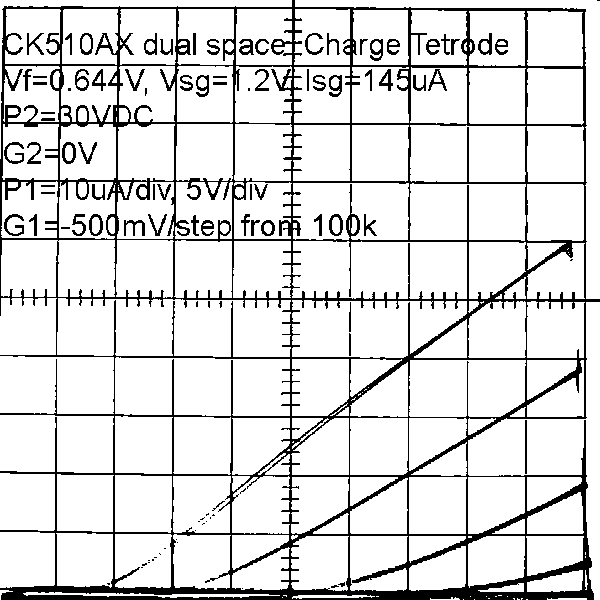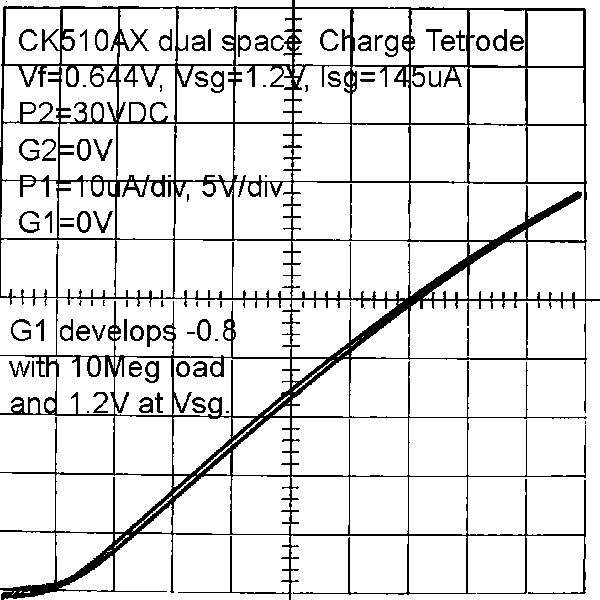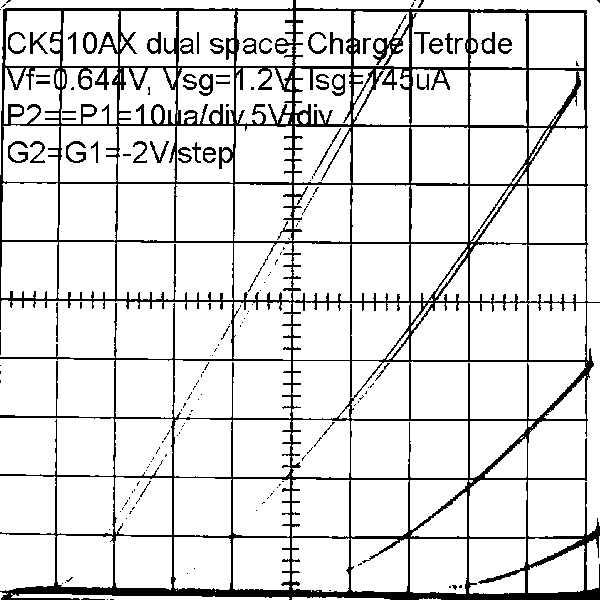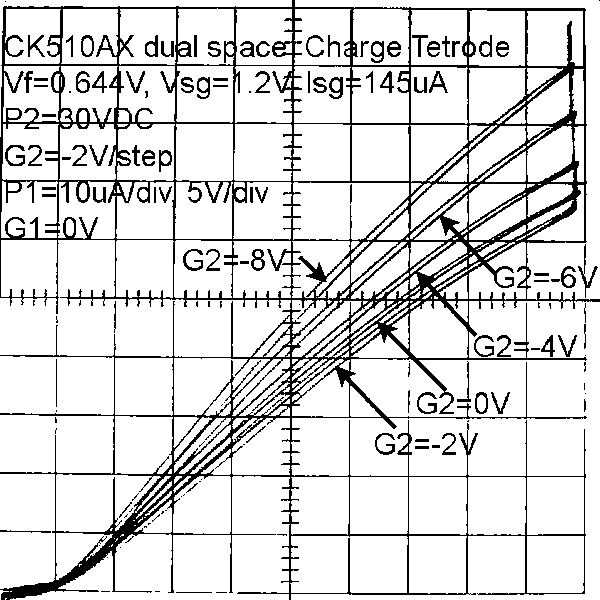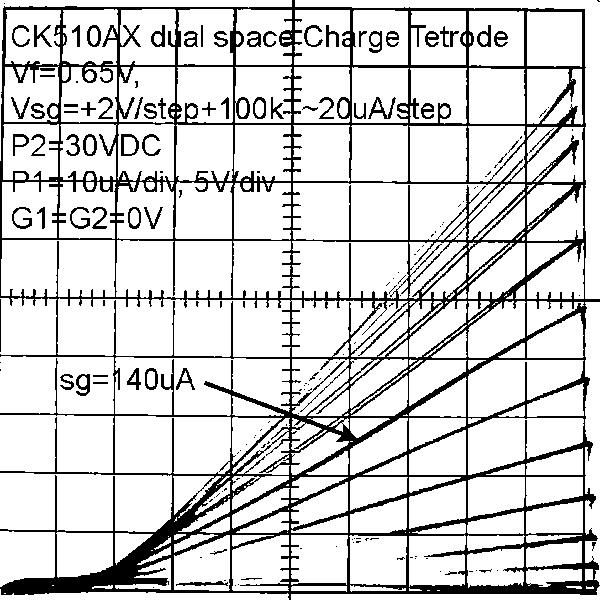
CK510AX
|
|
|
Hits: 2491 Replies: 1
CK510AX dual Tetrode in cascade amplification
|
|
|
Joe Sousa
22.Aug.11 |
1
Fellow Radiophiles: The CK510AX was designed as a special dual tetrode for cascade voltage amplification in hearing aid applications. This special design shares the single filamentary cathode to save battery power. The figure shows the arrangement of the various grids. There is a space charge grid around the cathode that not only permits low plate battery operation, but also serves to shield each tetrode half from each other. Two independent control grids serve as independent inputs. Two independent plates provide the two outputs. As space charge triodes, the plate characteristic is like that of a triode, not like a screen grid tetrode. In the intended application, the space charge grid is biased with 145uA that is provided by a recommended 200k resistor to the 30V battery supply. The remaining two control grids and their respective plates are wired as a conventional two stage audio amp. The amplifier input is at the first control grid, then the first plate drives the second grid with capacitor coupling. The output of the amplifier is taken from the second plate. The shielding action of the space charge grid is crucial to make this cascade of two audio amplifiers work with a shared filamentary cathode. If there was no space charge grid, the control action of the first control grid over the filamentary cathode current to the first plate would be nearly perfectly canceled by the negative feedback that the first plate would apply to the second control grid. For example, if the second control grid is 1/3 as effective as the first control grid over the first tetrode gain, this 1/3 disadvantage would be wiped out by being presented with a greatly amplified signal from the first plate which should have a gain >10X. In an indirectly heated triode with a single shared cathode, like the 6J6, the wide cathode sleeve shields the two triode halves. The very thin filamentary cathode of the CK510AX can't serve as a shield between the two tetrode halves. The cascaded amplifier application makes the space charge grid shielding necessary, but if the application was push-pull, as might be desirable for a power output stage, the shielding action of the space charge grid would be unnecessary. The degeneration that one grid would have on the other half, which might be 1/3, would not wipe out all gain because both grids would be driven with signals of the same magnitude, but opposing phase. In this case, the reduced tube gain, would be compensated by a push pull output with up to 4X more power capability than the same tube in single ended drive. Best regards, -Joe p.s.:Major correction on 2011-8-22. There are no screen grids in this dual tetrode in addition to the space charge grid. The "g2" pinout nomenclature caused this confusion. There is a total of three grids, comprising a common space charge grid and two control grids. |
|
Joe Sousa
24.Aug.11 |
2
Fellow Radiophiles: I have made a set of CK510AX curve traces to quantify what I presented above. These first three plots show the classic plate characteristic for a space charge tetrode, which looks just like the characteristic for a triode. The first plot was stepped with 100k at the grid, the second plot was stepped with the grid grounded, and the third plot shows twice the current for both sides shunted together. This plot for plate P1, with G1 grounded, shows the spurious effect from the control grid G2 of the second tetrode. G2 is incremented with -2V/step. Note that the second trace from the bottom corresponds to G2=0V, and the bottom trace corresponds to G2=-2V. Then the effect of G2 voltage on P1 current reverses direction to increase current as shown in the third trace from the bottom. This subtle non-monotonic effect was noticed when grounding G2 created a single trace that corresponded to the second trace from the bottom; otherwise there would be no reason to suspect that the stepped sequence would have a non-monotonic effect on plate current.
When G2 is more positive than -2V, the effect is analogous to a conventional grid, where a negative voltage restricts plate current flow. In this case, the field from G2 penetrates the shielding space charge grid, and reaches to the far side of the filamentary cathode. When G2 is more negative than -2V, repelling the cathode space charge toward the other tetrode plate becomes the dominant effect, and we have a spurious negative transconductance from G2 to P1. This is classic retarding field grid behaviour, as is seen in dual control pentodes from the suppressor grid to the screen grid. From an application point of view, the effect of one control grid on the opposite plate current is at a minimum at -2V bias. The primary application is the classic cascaded pair of audio amplifier stages, with the first plate driving the second control grid. When G2>-2V, there is then, a slight spurious negative feedback to the first plate current, and when G2<-2V, the feedback becomes positive. But neither of these feedback levels exceeds 10% of the primary transconductance from G1 to P1. At this point, I was was really curious about what was the most important task of the space charge grid, which was biased with 100k to 30V, as recommended in the Raytheon data sheet. Was this grid primarily a shield between the two independent tetrodes, or was it also providing significant space charge acceleration to contribute to plate current.
This plot shows how space charge grid current affects the plate current for the first triode. It is now clear that with zero space charge current, and zero voltage at the space charge grid, there is no plate current below 50V at the plate. The space charge grid is equally important as a shield between the two tetrode halves, as it is in it's conventional role of partially neutralizing the space charge around the cathode to increase plate current.
Best regards, -Joe |
End of forum contributions about this tube
| Data Compliance | More Information |

